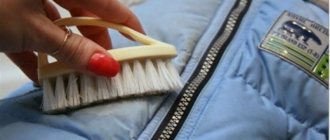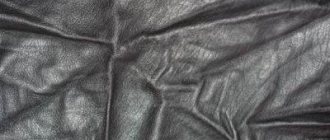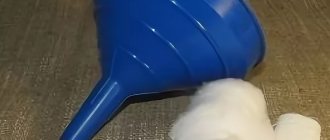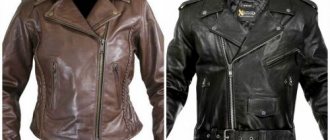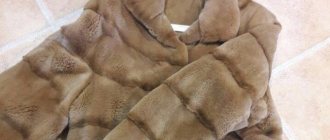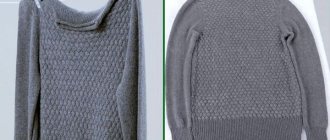It happens that you bought a blouse in an online store, but it turned out to be too big. Either this is an old and favorite thing, and the owner has lost weight.
Don't part with the clothes you like. There is always a way out of the situation.
Clothes can be altered to fit. This will provide psychological comfort and a good mood.
If you do not have sewing skills, and the fabric is expensive and complex, it is better to contact a specialist. But you can do the modification yourself.
There are several methods for altering clothes. There is no need to put things off for a long time; it is better to get down to work right away.
Is it possible to cut knitted items?
This can be done using a regular needle and thread or, for example, a crochet hook, if you walk a chain of air loops along the vertical jumpers. By the way, you can avoid manual work altogether if you have a sewing machine - just lay zigzag stitches along an imaginary cut line.
Interesting materials:
What material is best for building a house? What material is better for a sliding wardrobe? What material is better for the walls of the house? What material is best for panties? What material is better for a country house? What material is best for an umbrella? Which continent is the coldest and why? What is the minimum length of service required to receive an old-age insurance pension starting in 2024? What password can you come up with for the Appstore? What password can you come up with for PayPal?
Rework options
There are several different options for making your blouse smaller. The specific choice depends on the detail that turned out to be large.
To correct the cut you can:
- take the item to a professional tailor (atelier, private seamstress);
- start working on your own.
Everything is simple and clear if a specialist takes care of the clothes. You will have to come to the fitting 2 times and pay for the work.
But you can do without this if you get down to business yourself. First you need to determine what exactly needs to be done to solve the problem.
To reduce the size of a blouse, use the following work options .
- Deepen the front and back darts (on the chest, on the waist).
- The side seams are sutured.
- Reduce in the side seams, in the seam of the back flange.
- The shoulder seams are sutured.
- Reduce according to the sleeve if it is too big.
- They tighten and drape excess material.
- They rearrange and re-stitch buttons.
- Wash at a certain temperature, taking into account the quality of the fabric.
- Dried using a special method.
Shrinking a wool sweater in the washing machine
If the sweater has stretched after washing, wash the item in the washing machine. To do this, place the jacket in a special bag for washing clothes or use a regular light pillowcase. When washing, use a special detergent for washing woolen items, if it is a woolen jacket. Select the quick wash mode without spin and wash.
Once the process is complete, take out the woolen sweater or cardigan and gently wring it out. Then, in the correct form, lay the product on a horizontal surface on a terry towel. When the towel gets wet, replace it with a dry one, otherwise a musty smell will form. Leave the sweater to dry naturally until completely dry.
Reasons why a sweater may stretch
Old items may become deformed due to prolonged use. Even with proper use, clothes will not look new within 10 years of constant wear. Other reasons that cause thread stretching include:
- non-compliance with temperature conditions during hand washing;
- incorrectly set program on the washing machine;
- knitting features (large perforated pattern);
- habit of pulling on sleeves;
- improper storage;
- inappropriate detergent;
- improper drying, etc.
Ways to reduce the size of a blouse
Before starting to work with a new item, it is first soaked and then dried.
Once wet, the fabric will shrink and the blouse will become smaller. This is what you do with a product that needs to be reduced by 1 size.
Important: It is necessary to pay attention to the quality and structure of the fabric. For example, to prevent knitwear from stretching, it should not be hung out to dry.
Method 1 - make darts
Darts are made so that the product fits the figure. Begin laying from the side seam, slightly below the level of the armpit. The top point should be where the figure is most convex. They are sharpened on the parts from the inside out, after cutting. The line should end at the top point.
Method 2 - reduce along the side seam
To make your blouse smaller, you need to:
- Measure the product, volume.
- Calculate how much fabric is extra.
- Subtract 2-3 cm for a loose fit.
- Divide the rest in half.
- Set aside a few cm for the inside and side seams.
- Draw lines from the armhole to the bottom of the product.
- Baste.
- Do a fitting.
- Repeat the procedure if the blouse doesn’t fit well and not enough excess has been removed.
- Sew along the basting, retreating 1-2 mm.
- Remove the basting and secure at the end of the seams.
- Iron them.
Attention: If you always use a pattern, this will help you avoid big troubles when altering clothes.
Method 3 - reduce on the sides and back
They work the same way as in Method 2, but they also reduce the volume of the backrest:
- The excess is calculated.
- Leave centimeters for allowance so that the fabric fits easily.
- Remove excess fabric.
- They make notes.
- They sew by first pulling out the extra thread.
Method 4 - decrease in the shoulders
To reduce shoulder seams, you need:
- rip them apart;
- take measurements;
- build a drawing;
- cut a pattern;
- cut the material according to the pattern, leaving a few cm for seams and shrinkage;
- outline by hand;
- stitch up.
Method 5 - working with a sleeve
Reduce along the sleeve as follows:
- Plan how much to cut, starting from the sleeve and going down to the bottom.
- Draw a cutting line with chalk.
- If necessary, prepare a pattern.
- Remove excess material.
- Sew taking into account the seam allowance.
Method 6 - fold and drape
The fabric is draped.
- The excess is not cut off, but placed inside.
- The put aside material is pulled together (with a button, decorative pin, buckle, brooch. You can pin it with several buttons in a row. Loops are added).
We reduce the stretched collar (neck) by crocheting
Another thing I didn't like about this sweater was the collar. At first it seemed normal, but when worn (I wore it a couple of times at home), it stretched so that it could be worn on one shoulder.
Neck too big
But I want a normal neckline. Therefore, I simply crochet it, slightly tightening it in those places that I want to reduce. I use the same threads that were left after cutting the bottom of the sleeve.
Stretched neckline reduced by crochet binding
Another jumper's collar is fine, but the sleeves need reworking.
The neckline on the pink pullover suits me
We do exactly the same as with the previous one. Unravel the bottom of the seam.
We begin to unravel the seam
We take out the thread, cut it, separate the knitted fabric, unravel the lower part, winding the threads into balls. Crochet it.
Here I decided to knit several rows and finish with a scalloped edge, or picot. Simple and modest. The knitting itself is openwork. I want the bottom to be narrower at the wrist, so I knit it tightly.
Shortening the sleeves of a pink pullover
Initially, the cuffs were tied with an elastic band, but you can immediately see that it was of little use. Therefore, I simply made the bottom of the sleeves narrower; the arm will fit smoothly; you can also roll up the sleeves if you wish.
It seems like I always shorten my sleeves almost the same way, but it still turns out a little differently!
Sweater decor - alteration and decoration of knitted clothes with ribbons
If you are happy with everything about a sweater, but you want to modify the item, update it, decorate it, then this post talks about a simple but unusual original decoration of knitwear. Namely, ribbons. The color, thickness, and texture of the tapes can be different, and the final result depends on them.
Similar articles:
Machine embroidery of a sweater with flowers using free-motion technique Knitted and crocheted slippers with description - 4 models How to decorate a knitted sweater with beads with examples Bottle decor with crocheted napkins with beads Toys with patterns - a bear and a hare from a knitted sweater Crochet toys for beginners - bear, monkey Knitted hare, crochet egg warmers-covers for the kitchen Openwork crocheted blouse with sleeves made from motifs for the summer, diagram...
Tools and materials for work
Before starting work, you need to select and prepare the necessary tools and materials.
To remake a shirt at home you will need
- set of needles of different formats
- threads (different numbers and colors. Suitable ones are selected from them, depending on the structure and color of the fabric);
- scissors (large, small and medium);
- pins;
- thimbles (to protect fingertips);
- various accessories (buttons, decorative brooches, buckles);
- crayons;
- sewing machine;
- iron and ironing board.
Professionals also use:
- patterns;
- cardboard (thick paper);
- measuring tape;
- a box of wax (for waxing the thread);
- threader;
- cutter (special copy roller for making marks on the material);
- carbon paper (for transferring the drawing);
- transparent template ruler;
- overlock
How to wash so that only the sleeves shrink?
If you are not satisfied with only the sleeves in a knitted product (for example, you pulled them unsuccessfully when putting on a sweater), then you can try to reduce only their length or width. For this:
- spray the sleeves with water from a special spray bottle or simply wet them carefully without touching other areas;
- lay the item horizontally again, straighten the sleeves and give them the required shape in length or width;
- wait for it to dry.
Advice! You can also try simply steaming only the sleeves. The main thing is that hot steam does not get on the main part of the blouse.
Little tricks for repairing knitwear
Short women often face this problem: the long sleeves of their favorite dress make it difficult to wear this product. They need to be hemmed using different techniques.
Blind seam
The blind seam, made by hand, looks great.
- First, bend the sleeve to the required length, iron it without smoothing the fabric, but applying the iron so as not to stretch the stitching.
- Then sew a basting stitch.
- Next, choosing one of the hidden seams, fold the sleeve of the dress.
Oblique seam
A running bias stitch is perfect for holding layers of fabric together. The needle goes from top to bottom or bottom to top.
The best choice is a seam where small spaces are left between short stitches.
Seam, needle forward
You can hem this part with a seam similar to machine stitching. This is the most reliable of the hand stitches:
- Insert the needle into the tissue, then after 5 mm bring it forward.
- Insert the needle again, stepping back from the needle exit point by 3 mm.
- Pull the needle out at a distance of 6 mm (= double stitch length).
- Then bring the needle to the point of the first needle withdrawal and bring it out again at a distance equal to twice the length of the stitch, continue in the same way from right to left, as in the figure.
Another type of stitch, which is performed from right to left, will help to hem unnoticeably.
Goat
The finishing seam “Kozlik” is also considered strong and reliable. Its disadvantage is the ability to catch on something sharp.
The stitch should be done from left to right.
Operating procedure:
- Finish the bottom of the sleeves with an overlocker.
- Turn the hem allowance inside out and press.
- Hem with a goat stitch.
To do the job correctly and accurately, use a needle to grab one or two threads of the fabric above and below from the edge of the overlock stitch. The distance between the grips is approximately 1 cm, but no more. Before fastening the thread, stretch the fabric slightly.
How to make decorative stitching
To decorate a dull project, you can highlight the hem stitches with a different color thread using a double or triple decorative stitch. The optimal stitch width is 2.5 cm.
Finish the bottom of the sleeves with an overlocker. Turn the hem allowance inside out and press.
Use a blind stitch on your sewing machine. Adjust the stitch width so that the needle lightly catches the fabric at the fold. Try it on a separate piece of paper first.
Then sew a seam along the exposed edge of the hem allowance. The best stitch length is 1 mm.
If the sleeves are long, what should I do?
Every person has knitted items. They are comfortable, practical, and keep you warm in cool weather. But the problem is that their sleeves often stretch or sag.
It's okay, they can be carefully hemmed. Knitted fabric differs from ordinary fabric in its structure, so you need to be patient in order to beautifully process the bottom of this part.
If a machine-knitted sweater has long sleeves, then we will do this work.
Operating procedure:
- On the product with cuffs, mark the new length. For example, you need to shorten it by 10 centimeters, measure 10 centimeters upward from the cuff with a ruler, draw a cutting line with chalk, leaving 1-15 cm for sewing on the cuff.
- Cut off the cuffs and sleeve along the marked line.
- We put a needle on the machine for sewing knitwear, selecting the “knitted stitch” function. If there is no such needle, then we leave the same needle, put a “zigzag”, the width of the step is 1-2, and the length is 2-3 to get an elastic seam.
- We remove the front part of the car and put the sleeve on the protruding part. We process the cut part.
- If the sleeve is too wide, step back 1 cm from the edge, sew a line in wide increments, and tighten it to the required size.
- Place the cuff face to face on the finished edge and sew with a zigzag stitch.
- We process the cuts using an overlocker or by hand.
Ways to prevent woolen items from stretching after washing
In order to avoid the not-so-pleasant procedure of shrinking your favorite sweater, follow some rules during and after washing it:
- If possible, wash it in warm water by hand or use a delicate machine wash cycle;
- do not twist it when squeezing, let the water drain in its natural position;
- Do not dry the item in a vertical position: always lay it out on a flat surface;
- do not dry it on a hot radiator or in the open sun, as it will not only lose its shape, but may also fade;
- it must be ironed either through a cloth or by steaming without contact with the hairs;
- Do not dry or store knitted sweaters on hangers - they will definitely stretch out. It's better to keep them folded in the closet.
Which blanket is better - sheep's wool or bamboo?
Crafts from satin ribbons
How to reduce a wool sweater size
You can restore a woolen or knitted sweater manually. To do this, fill the bath with warm water at a temperature of about 40 degrees. Then immerse the stretched sweater completely in water and straighten it to the correct shape. Leave the product for a few minutes so that the material is saturated with moisture. After this, take out the jacket and squeeze it lightly.
You can wash woolen items in hot water at a temperature 20 degrees higher than that indicated on the sweater or jumper label. Soak the item for 20-30 minutes in hot water, then wash as usual and rinse in cold water. A sharp temperature change can correct the situation. After rinsing, lightly wring out the material.
When you wring out woolen or knitted items, do it carefully and do not twist the items, otherwise they will stretch even more! After rinsing, lay the jacket horizontally on a terry towel, straighten it and shape it into the desired shape. Leave to dry completely at room temperature and replace the towel as soon as it gets wet.
If your denim jacket is stretched
- To shrink a denim jacket in a certain area, for example, in the waist, sleeves or shoulders, mix warm water and conditioner in a ratio of 3 to 1. Spray the solution on the desired area and dry the product in an electric dryer, washing machine or radiator. Repeat the procedure until you get the required size;
- Wash denim in the washing machine at the highest temperature setting on the intensive or wrinkle-resistant cycle. Then dry the jacket and iron the dried material with a hot iron;
- An old and worn denim jacket, as well as a light-colored denim jacket, can be boiled. To do this, place the product in boiling water and cook over medium heat for 30 minutes. It is important that the clothing is completely submerged in water. This method will dull the color, resulting in a “washed” denim jacket with a smaller size;
- To prevent denim from shrinking, wash the material by hand at temperatures up to 40 degrees. Do not dry items in the fresh air or throw them over a rope, otherwise streaks and marks will remain. You can read more about caring for denim in the article on how to reduce jeans size.
How to wash something made from several different materials?
If the product contains both natural and synthetic materials, pay attention to the specific composition and recommended temperature conditions . Unfortunately, synthetic things are quite difficult to revive.
For example, it is almost impossible to shrink polyester. However, we advise you to try reducing the size of the item first only in those areas that have stretched. Also, do not immediately use extremely high temperatures - the wool contained in the composition may still shrink to child size. It is better to use the contrast wash method.
Shrinking a sweater by dry cleaning
The simplest and fastest method to get rid of this problem is to go to a dry cleaner, where there is a special service for reducing stretched wool items. Using heat treatment or washing, specialists will return the product to its original appearance and desired size in a matter of minutes. However, this method can negatively affect the softness and brightness of the item , making the item scratchy and the shade dull. Therefore, when changing the shape of a colored or colorful wool item, it is advisable to ask dry cleaning specialists to add a product to soften the fabric, and also to use a gentle method to maintain color saturation.
How to prevent things from stretching?
Delicate fabrics should be washed according to the manufacturer's recommendations. Do not increase the water temperature and the number of spin speeds. When washing by hand, it is recommended to avoid prolonged soaking, for several hours. It is better to remove difficult stains using special products designed for delicate fabrics.
When washing, you can add conditioner to the water. It will make the fabric soft and less susceptible to deformation. Additionally, it is recommended to use water that has passed through a purification filter.
In addition to spinning at high speeds in the washing machine, delicate items are afraid of twisting. Fabric stretching also occurs if items are dried vertically. For this reason, sweaters and cardigans should not be hung on trempels or secured to a clothesline with clothespins. In a closet, it is recommended to store such things on a shelf, especially if they are heavy.
To avoid having to make the sweater smaller, when wearing it, it is recommended to give up the habit of pulling the sleeves, trying to cover the hands with them. In this case, it is recommended to immediately purchase a product whose style implies a lowered (elongated sleeve).
You need to take off your sweater correctly. To prevent it from stretching, it is recommended to take the product by the bottom edge and, using the method of turning it inside out, lifting it up, remove it over the head at the same time as the sleeves.
Sewing the shirt at the shoulders
There are two ways to change the shoulder size.
Without using ripping
You need to do the following:
- Step 1. Using a measuring tape, measure the required length from the collar to the far shoulder line, draw a line here.
- Step 2. Draw with chalk a place for the future seam, which should end at the edge of the armpit line.
- Step 3. Fold the item in half and cut the fabric along the drawn line. If the instructions are followed correctly, the sleeves and body of the shirt should become separate pieces.
- Step 4. Pin the cut sleeve with the back and front. It is necessary to connect the parts so that there are no holes. Remember that the armhole size has become larger.
- Step 5. Sew the joined parts and iron. The product is ready to wear.
By tearing
You need to do the following:
- Step 1. Determine your desired shoulder length and mark it on the fabric. It is also necessary to draw a line that will be parallel to the seam of the sleeve.
- Step 2. Remember to check for symmetry, otherwise the sleeves will be different sizes.
- Step 3. At this stage, you need to open the seams and carefully flog the sleeves.
- Step 4. After cutting off the excess fabric, connect the sleeves and openings for them. Then the parts need to be double stitched.
For more precise instructions, use this video tutorial.
In order to rip the seam correctly and accurately, use a special seam ripper. To do this, insert its thin tip under the thread and pull it up. Do this operation with each stitch.
Remember that you can only rip a seam on one side.
When is it better to entrust the rework to a professional?
Skilled craftswomen independently handle any detail of sewing a standard garment. For them, a blouse is an easy material to work with due to several simple operations with a needle and a sewing machine.
If you don’t have firm confidence in your skills, then to guarantee results without throwing things away, it’s better to turn to professionals. They will do all the work quickly and efficiently.
What can be sewn from chintz
What to wear with plaid shorts
Cotton
Practice shows that a cotton T-shirt stretches even faster than a wool sweater.
But even in this case, it is possible to adjust the shape of the thing. It is worth considering that when working with cotton, restoration is only possible if the clothing was sewn correctly. If the threads are located and directed incorrectly, then nothing can be done. Cotton products give maximum shrinkage in the following cases:
- Machine wash using very hot water and maximum spin.
- The product can simply be dipped in boiling water. True, even a short stay of a colored product in such hot water can provoke it to shed. But just five minutes of treatment will reduce the item by size, a quarter of an hour in boiling water and the clothes will become 1.5-2 sizes smaller.
- If you don’t want to risk the color of the item, then it is better to wash it in the traditional way, and then put it in an electric dryer.
We evaluate the result based on the completely dried product. If you can't do anything the first time, you shouldn't even try again. The positive effect most likely will no longer occur, but the item will ultimately be damaged. In this case, you will have to contact a studio or update your wardrobe.
If cotton clothing needs to be reduced in size, it should be machine washed in hot water. After adjusting the temperature on the washing machine, you need to set the temperature to more than 40 °C. If shrinkage by one or two sizes is required, the temperature should be set to the highest.
Cotton fabric stretches and contracts during the manufacturing process. When it heats up, the tension in the filament decreases, causing it to shorten. Heating can successfully shrink almost anything. You need to use the longest wash cycle. High temperature along with water and cycling will be very effective.
To significantly shrink the item, you can put it in boiling water and hold it there for 10-20 minutes. The duration of the procedure promotes greater shrinkage. After boiling, the product must be rinsed in cold water.
Compared to other fabrics, the problem of how to wash cotton so that it shrinks is not particularly difficult. T-shirts made from this material stretch even faster than a wool sweater. But there is always the opportunity to return the product to its original shape.
How to wash cotton so that it shrinks?
There are two ways to reduce shrinkage:
- First: a cotton jacket is placed in a washing machine, powder is added to the detergent container and a cycle is started with the temperature set to 60 degrees. Dry in a machine or on a clothesline, then iron and try on. This is the whole trick. Things will shrink after this procedure.
- Second: first you need to wash the cotton cardigan in the machine, then soak it in water (it should be boiling water) and wait until it cools down. After that, the item is transferred to a container with ice liquid, you can add ice cubes, squeeze it out and hang it on a clothesline to dry.
- Ironing will help shrink clothes. After washing and drying, the iron is turned on to maximum temperature and the supply of hot steam is activated. Just don’t keep the device in one place for a long time, as you could ruin your favorite blouse.
The result is assessed based on a completely dried and ironed product. If you didn’t succeed in reducing the item the first time, you shouldn’t try it a second time.

